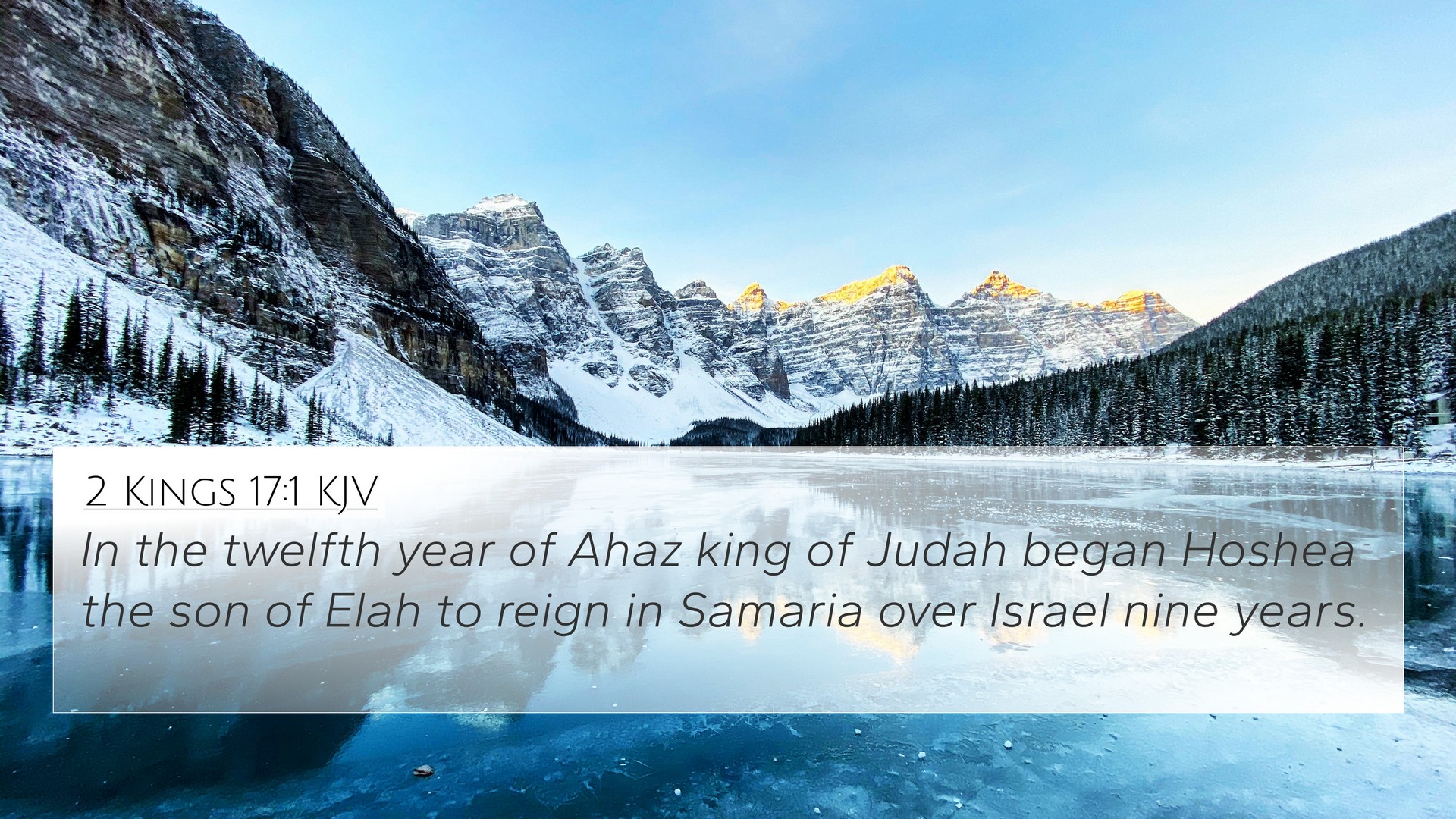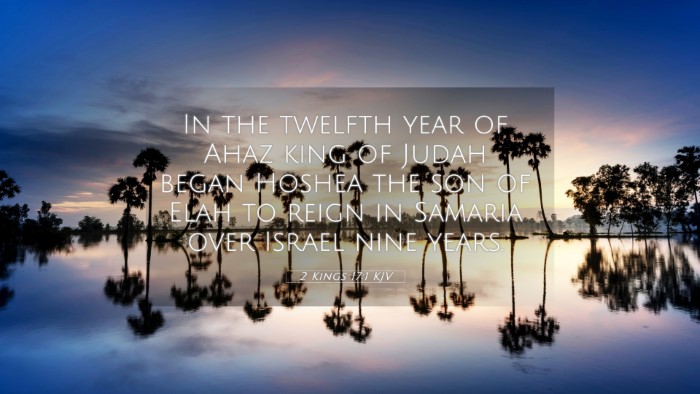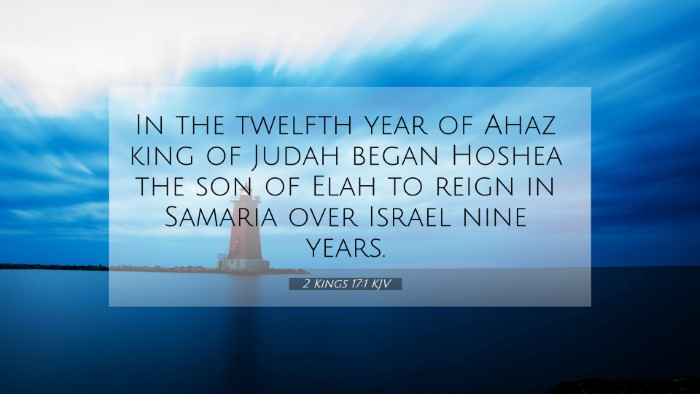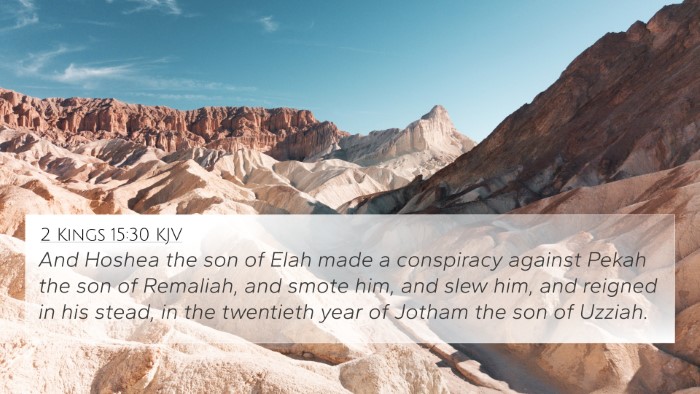Understanding 2 Kings 17:1
Verse Reference: 2 Kings 17:1
Text: "In the twelfth year of Ahaz king of Judah began Hoshea the son of Elah to reign in Samaria over Israel nine years." (2 Kings 17:1, KJV)
Summary of Key Themes
This verse marks a significant transition in the history of Israel, emphasizing leadership changes and the cyclical nature of Israel's kings. The verse introduces Hoshea, the last king of Israel before its exile, calling attention to the political and spiritual decay of the nation during his reign.
Commentary Insights
-
Matthew Henry:
Henry explains that the mention of Ahaz serves to highlight the political backdrop of Hoshea's reign. Ahaz was a wicked king whose actions led to a series of judgments against Israel. Hoshea's ascendance symbolizes the culmination of a period filled with idolatry and rebellion against Yahweh.
-
Albert Barnes:
Barnes notes the significance of the character of Hoshea, indicating that his reign was marked by conquests and challenges. While he was the last king to reign over the Northern Kingdom, his story serves as a foreshadowing of the impending Assyrian conquest and exile, illustrating the consequences of turning away from God.
-
Adam Clarke:
Clarke draws attention to the timing of Hoshea's reign, suggesting a connection with God's prophetic warnings. The text indicates that the political instability of Israel is tied to spiritual corruption, and Clarke emphasizes how leadership impacts the national fate.
Bible Verse Cross-References
This verse can be linked with several others that provide a deeper understanding of its implications:
- 2 Kings 15:30: Discusses the overthrow of Pekah and the rise of Hoshea, marking political turmoil.
- 2 Kings 15:16: Illustrates the widespread violence during this period.
- 2 Chronicles 28:19: Highlights Judah's failures during the reign of Ahaz, setting the stage for Israel's plight.
- Amos 7:1-9: Prophetic warnings during the reign of Jeroboam II, related to Israel's impending judgment.
- Isaiah 7:17: Foretelling of the consequences of Ahaz's reign, which also impacts Hoshea's time as king.
- 2 Kings 17:6: Describes the ultimate fall of Samaria, leading to the exile of Israel.
- Hosea 1:1: Directly addresses prophecy during Hoshea's reign, offering insights into the spiritual condition of Israel.
- 2 Kings 18:1-2: Shows the transition to Hezekiah's reign, emphasizing the continuity of judgment and response to leadership.
- Deuteronomy 28:15-68: Details the blessings for obedience and curses for disobedience, encapsulating Israel's plight.
- Jeremiah 31:5: Prophecy concerning Israel's future restoration, providing hope amidst judgment.
Thematic Connections
The reign of Hoshea encapsulates themes present throughout the Biblical narrative:
- Leadership Influence: The emphasis on how kings lead their nations either towards righteousness or ruin.
- Judgment and Grace: The dual themes of judgment against Israel and the promise of restoration.
- Historical Cycles: The recurring patterns of sin leading to exile and the hopeful return as expressed in the prophetic books.
- Faithfulness of God: Despite Israel's rebellion, God's overarching plan for redemption is continuously revealed.
Application for Study and Understanding
As we study this verse, it is essential to understand:
- How cross-referencing Biblical texts enhances our understanding of God's plans throughout history.
- Utilizing tools for Bible cross-referencing can provide depth to our theological reflections.
- The importance of identifying connections between Old and New Testament to see the coherence of God's narrative.
- Studying Bible verses related to themes of leadership and judgment can yield powerful insights for personal application.
Conclusion
2 Kings 17:1 provides a critical look at the last days of the Northern Kingdom of Israel. By examining the connections between Bible verses and the insights from public domain commentaries, we can better appreciate how each leader's decisions reflected broader spiritual truths. The thematic connections, coupled with cross-references, demonstrate the enduring relevancy of these ancient texts in our modern understanding of faith and leadership.



